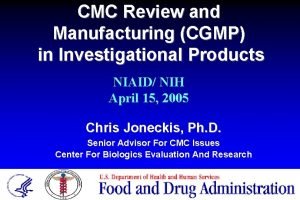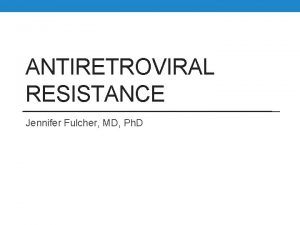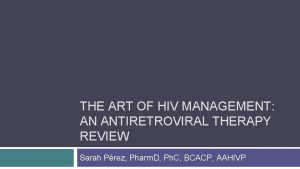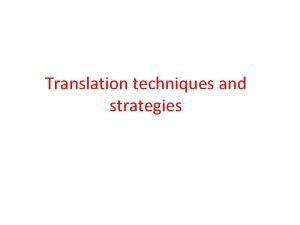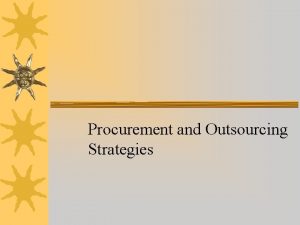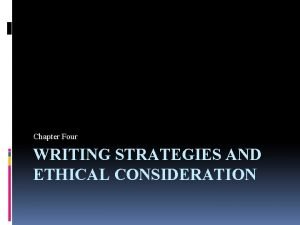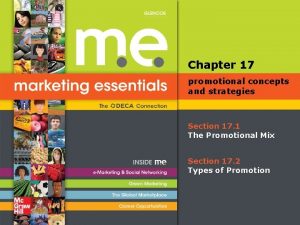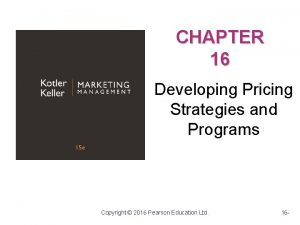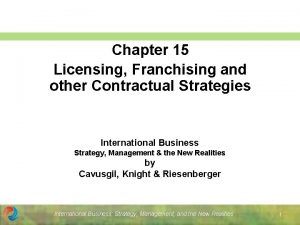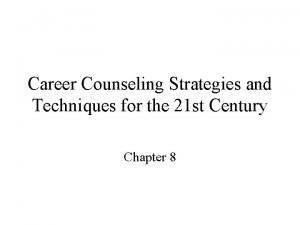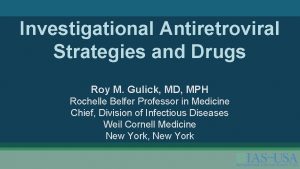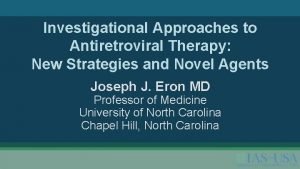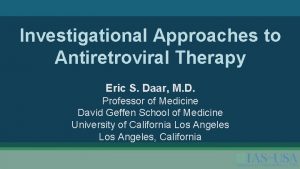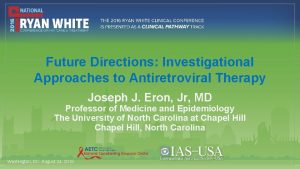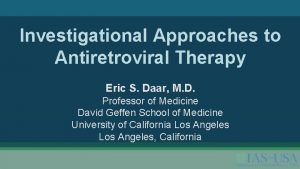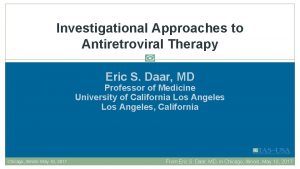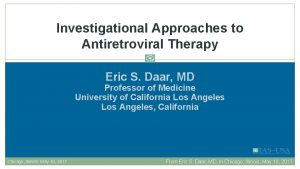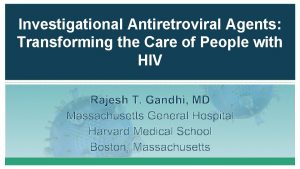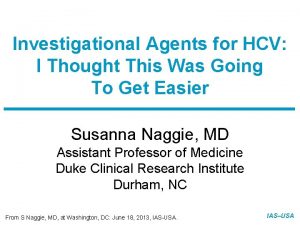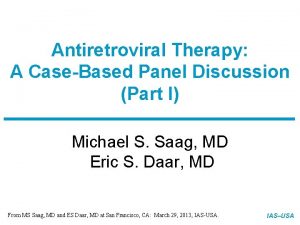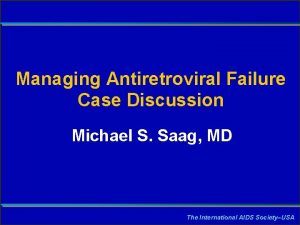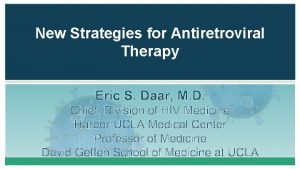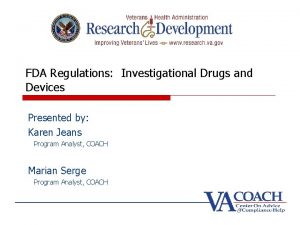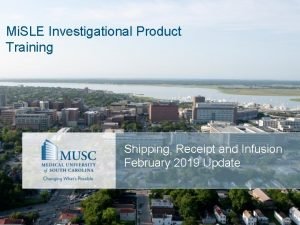Slide 1 of 36 Investigational Antiretroviral Strategies and
































- Slides: 32

Slide 1 of 36 Investigational Antiretroviral Strategies and Drugs Roy M. Gulick, MD, MPH Rochelle Belfer Professor in Medicine Chief, Division of Infectious Diseases Weil Cornell Medicine New York, New York

Slide 2 of 36 Financial Relationships With Commercial Entities Dr Gulick has no relevant financial affiliations to disclose. (Updated 04/03/18) Slide 2 of 33

Slide 3 of 36 Learning Objectives After attending this presentation, learners will be able to describe: • The latest data on investigational antiretroviral drugs • The latest information about long-acting antiretroviral drugs • Antiretroviral agents with new mechanisms of action Slide 3 of 33

Antiretroviral Drug Approval: 1987 - 2019 BIC IBA DOR AZT Slide 4 of 33 NFV DLV APV TDF RTV EFV LPV/r IDV ABC NVP 3 TC SQV dd. C d 4 T dd. I ENF ATV FTC FPV ETR RAL MVC DRV TPV DTG TAF EVG RPV

Question #1 Which of the following investigational drugs is earliest in clinical development? 1. Cabotegravir 2. EFd. A 3. Fostemsavir 4. GS-2607 Slide 5 of 33

Newer ART Agents (partial list) NRTI NNRTI PI II MI CI GSK 2838232 GS-6207 fostemsavir cabotegravir PRO 140 (leronlimab) UB-421 Phase 3 Phase 2 censavudine MK-8591 (EFd. A) Phase 1/2 elvucitabine Preclinical GS-9131 Slide 6 of 33 EI elsulfavirine TMC 310911 cenicriviroc PF-232798 GSK 364025

NRTI Needs: • more convenient • active against drug-resistant viruses Slide 7 of 33

MK-8591 (EFd. A) • 4’-ethynyl-2 -fluoro-2’deoxyadenosine; EFd. A • DNA chain terminator • Inhibits RT by preventing translocation (NRTTI) • Half-life = 50 -60 hours in plasma • Accumulates in LN, vagina, rectum (animals) Grobler CROI 2017 #435 • Potent antiviral activity (PBMC EC 50 = 0. 2 n. M) with broad coverage (HIV-1, HIV-2, MDR strains) • Low-dose and parenteral formulations Slide 8 of 33 Slide 8 of 36 Matthews IAS 2017 #TUPDB 0202 LB

MK-8591: Activity Against NRTI-Resistant Strains Slide 9 of 33 Grobler CROI 2019 #481

MK-8591 (EFd. A) • Double-blind, placebo-controlled, 3 -panel trial • HIV- participants • MK-8591 (or placebo) daily 5 mg X 6 weeks, 0. 75 mg X 4 weeks, 0. 25 mg X 4 weeks • Results: • After 2 -3 weeks of dosing, MK-8591 -TP levels exceeded 1. 0 pmol/million cells (similar to 10 mg weekly dosing) • Tissue (vaginal, rectal) and PBMC levels adequate • Conclusion: Low daily doses expected to suppress HIV Matthews CROI 2018 #26 • Phase 2 b study in rx-naïve of MK-8591 + 3 TC + DOR • Considering weekly dosing regimens Slide 10 of 33

MK-8591 -- Prevention • MK-8591 3. 9 mg/kg weekly was 100% protective in 8 macaques given multiple weekly intrarectal SHIV challenges Markowitz IAS 2017 #MOAX 0203 LB • Follow-up study with lower doses • MK-8591: 1. 3, 0. 43, 0. 1 mg/kg weekly (8 macaques/group) • Results • 1. 3 mg/kg: all 8 remained uninfected • 0. 43 mg/kg: all 8 remained uninfected • 0. 1 mg/kg: 2 of 8 became infected • Conclusions: • MK-8591 protective at low doses • Equivalent to 250 µg/week or 10 µg/day in humans Markowitz CROI 2018 #89 LB Slide 11 of 33

Long-Acting Subdermal Implants: MK-8591 in Animal Studies Drug-eluting implants, both bioerodible and non-erodible polylactic acid polycaprolactone ethylene vinyl acetate rats non-human primates plasma PBMCs Barrett AAC 2018; 62: e 01058 -18 Slide 12 of 33

INSTI Needs: • more convenient • active against INSTI-resistant virus Slide 13 of 33

Cabotegravir (CAB) • Integrase inhibitor similar to DTG; similar resistance • Potent in HIV+ individuals (5, 10, 30, 60 mg oral) Spreen HIV Clin Trials 2013; 14: 192 • • Nanotechnology formulation; SC + IM injections T ½ 21 -50 days! Supports monthly, bimonthly or quarterly dosing Safety: ISR (mostly mild) and nodules with SC Spreen JAIDS 2014; 67: 481 dosing • Phase 1, 2, and 3 studies completed Slide 14 of 33

Phase 2 b: LATTE-2: IM CAB + IM RPV • • Randomized, open-label, phase 2 b, non-inferiority study Study population: ART-naïve (N=309) Study rx: PO CAB + ABC/3 TC X 4 wks, then randomized 2: 2: 1 Results (HIV RNA <50 at 96 wks) week 160 – IM CAB + IM RPV q 8 wks – 94% 90% – IM CAB + IM RPV q 4 wks – 87% 83% Margolis Glasgow 2018 #P 118 – PO CAB + ABC/3 TC – 84% • Injection site reactions were nearly universal • 97%+ were mild or moderate; lasted a median of 3 days • 2 pts (<1%) d/c due to ISR • Conclusions: IM non-inferior (comparable) to PO; well-tolerated Eron IAS 2017 #MOAX 0205 LB; Margolis Lancet 2017; 390: 1499 Slide 15 of 33

CAB Phase 3: FLAIR • Randomized, international, open-label, non-inferiority (∆6%) • Study population: rx-naïve adults (N=629; 22% women) • Study rx: ABC/3 TC/DTG X 20 wks CAB + RPV (oral X 4 weeks, then IM monthly) or continue oral DTG regimen • Results (week 48): – 3 VF on LA: 3 Russian (A 1) • NNRTI and INSTI subs. – 3 VF on oral: no resistance – ISR ~70% -- mild, transient • Conclusion: CAB + RPV non-inferior Orkin CROI 2019 #140

CAB Phase 3: ATLAS • Randomized, international, open-label, non-inferiority (∆6%) • Study population: adults with VS on 2 NRTI + PI, NNRTI, or INSTI regimens (N=616; 33% women) • Study rx: continue ART or change to CAB + RPV (oral X 4 weeks, then IM monthly) • Results (week 48): – 3 VF: 2 Russian (A/A 1) • NNRTI and INSTI subs. – ISR ~70% -- mild, transient • Conclusion: CAB + RPV non-inferior Swindells CROI 2019 #139

CAB – Prevention: HPTN 077 • Phase 2 a randomized, double-blind, placebo-controlled • Study pop: low-risk HIV- participants (N=199); median age 31, 66% women, 34% men • Study meds: 3: 1 to oral CAB X 4 wks then CAB IM 800 mg q 12 weeks or 600 mg q 8 wks (or placebo) • Results: – ISR more common with CAB (34%) vs. PBO (2%); 1. 5% d/c’ed – No other differences in safety/tolerability – drug troughs lower with CAB 800 q 12 wks • Conclusion: CAB 4 wk oral 600 mg IM q 8 wks optimal Slide 18 of 33 Landovitz PLo. S Med 2018; 15: e 1002690

HPTN 077: CAB and Weight Gain Baseline Week 41 Conclusion: In HIV-negative individuals, no significant changes in weight on CAB (vs. placebo) over 41 weeks Landovitz CROI 2019 #34 Phase 3 Pr. EP studies (IM CAB vs. oral TDF/FTC) enrolling. Slide 19 of 33

Question #2 Which of the following new HIV drug classes is farthest along in clinical development? 1. Attachment inhibitor 2. Capsid inhibitor 3. CXCR 4 antagonist 4. Maturation inhibitor Slide 20 of 33

Entry Inhibitors Needs: • Novel mechanism of action • More convenient dosing Slide 21 of 33

HIV Entry Inhibitors CD 4 Binding Coreceptor Binding CCR 5 Inhibitors maraviroc* fostemsavir gp 41 Virus-Cell Fusion enfuvirtide* gp 120 ibalizumab* V 3 loop CD 4 Cell Membrane Slide 22 of 33 * = FDA approved CCR 5/CXCR 4 (R 5/X 4) Adapted from Moore JP, PNAS 2003; 100: 10598 -10602.

Fostemsavir (FTR): Oral HIV Attachment Inhibitor • • Prodrug of temsavir (TMR) Inhibits CD 4 binding by binding to gp 120 PK suggests daily dosing without boosting Phase 1 dose-escalation over 8 days – 5 doses (4 with RTV) – up to 1. 5 log cps/ml ↓ – ↓ baseline susceptibility in 12% of pts due to envelope polymorphisms Slide 23 of 33 Nettles JID 2012; 206: 1002

Fostemsavir (FTR): Oral HIV Attachment Inhibitor • Phase 2 b: modestly rx-experienced, screened for susceptibility (IC 50 <100 n. M) (N=251) – Study rx: TDF + RAL + 4 FTR doses: 400 mg bid, 800 mg bid, 600 mg qd or 1200 mg qd (vs. ATV/r) – Week 48: 61 -82% VL <50; dose then ↑ to 1200 mg qd – Week 96: 61% VL <50 (MITT) Thompson Antivir Ther 2017; 22: 215 – No TDF or ATV resistance; 6 on FTR developed RAL resistance; 13 with available phenotypes showed ↓ susceptibility to temsavir and 7 had substitutions in gp 120 Latilliade JAIDS 2018; 77: 299 – Week 192: “comparable rates of virologic suppression” to ATV/r Thompson CROI 2019 #483 Slide 24 of 33

Fostemsavir (FTR): Oral Attachment Inhibitor BRIGHTE (Phase 3): heavily rx-experienced, NOT screened for susceptibility (N=272 with 1 -2 remaining ART classes randomized to FTR 600 mg bid or placebo; 99 with no remaining ART classes non-randomized) • day 8 (primary endpoint): mean HIV RNA ∆: -0. 2 log (placebo) vs. -0. 8 cps/ml (FTR) (p<0. 0001) • then, optimized background ART • wk 48: VL <40: 54% (randomized) vs. 38% (nonrandomized) Aberg/Ackerman Glasgow 2018 #344 • Comparable results by gender Quercia CROI 2019 • FDA “breakthrough status” July 2015 • Planned filing for approval 2019

New Mechanisms of Action Slide 26 of 33

HIV Maturation Inhibitors (MI) maturation inhibitor Slide 27 of 33

HIV Maturation Inhibitors • Bevirimat – phase 2 – ~50% of treatment-experienced patients had no response due to polymorphisms in gp 120 Mc. Callister 2008 XVII HIV Drug Resistance Conference #8 • GSK 3532795/BMS-955176 – phase 2 b – TDF/FTC + ‘ 795: 76 -83% <40 cps/ml – GI intolerance Morales-Ramirez PLo. S One 2018; 13: e 0205368 • GSK 2838232 – phase 2 a – ‘ 232 + cobicistat: up to ↓ 1. 7 log cps/ml at 10 days De. Jesus CROI 2019 #142 • GSK 3640254 – phase 1 pending; phase 2 starting

HIV Capsid Inhibitors X X X Sager CROI 2019 #142 Slide 29 of 33

Capsid Inhibitor: GS-6207 • • Potent antiretroviral activity: EC 50 140 p. M in PBMC Active across all tested subtypes Resistant variants have low fitness ↓ clearance and solubility very long ½ life: 30 -43 days • Phase 1 single SQ dose (vs. placebo) in HIV- (10/group) – Doses: 30, 100, 300, 450 mg – Prolonged exposure (>24 wks) – 3 highest doses >prot-adjusted-EC 95 at 12 wks • Phase 1 in HIV+ underway Sager CROI 2019 #480

Acknowledgments • • • Cornell HIV Clinical Trials Unit (CCTU) Division of Infectious Diseases Weill Cornell Medicine AIDS Clinical Trials Group (ACTG) HIV Prevention Trials Network (HPTN) Division of AIDS, NIAID, NIH • The patient volunteers! Slide 31 of 33

Slide 32 of 36 Question-and-Answer Slide 32 of 33
 Investigational product manufacturing
Investigational product manufacturing Antiretroviral
Antiretroviral Antiretroviral
Antiretroviral Heel and toe heel and toe slide slide slide lyrics
Heel and toe heel and toe slide slide slide lyrics Slide divide factoring
Slide divide factoring What is translation loss
What is translation loss Product life cycle kotler
Product life cycle kotler Security strategies in windows platforms and applications
Security strategies in windows platforms and applications Security strategies in windows platforms and applications
Security strategies in windows platforms and applications What is reading and types of reading
What is reading and types of reading Promotional concepts and strategies
Promotional concepts and strategies Procurement strategy outsourcing
Procurement strategy outsourcing Factors contributing to organizational politics
Factors contributing to organizational politics Direct investment and collaborative strategies
Direct investment and collaborative strategies Types of reading skill
Types of reading skill Examples of ifsp outcomes and strategies
Examples of ifsp outcomes and strategies Writing strategies and ethical considerations
Writing strategies and ethical considerations Chapter 7 strategic management
Chapter 7 strategic management Implementing strategies management and operations issues
Implementing strategies management and operations issues Chapter 7 strategic management
Chapter 7 strategic management An embryonic industry is one that:
An embryonic industry is one that: A packaging that promotes social and political causes.
A packaging that promotes social and political causes. Chapter 2 developing marketing strategies and plans ppt
Chapter 2 developing marketing strategies and plans ppt Intensive integrative and diversification growth strategies
Intensive integrative and diversification growth strategies Pricing and distribution strategies
Pricing and distribution strategies Promotional concepts and strategies
Promotional concepts and strategies Developing price strategies and programs
Developing price strategies and programs Licensing franchising and other contractual strategies
Licensing franchising and other contractual strategies Designing and implementing branding strategies
Designing and implementing branding strategies Designing and implementing branding strategies
Designing and implementing branding strategies Counseling strategies and techniques
Counseling strategies and techniques Aggregate planning strategies advantages and disadvantages
Aggregate planning strategies advantages and disadvantages Four strategic choices for mnes
Four strategic choices for mnes
